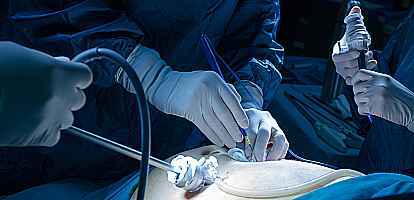Introduction
A rectocele is a type of pelvic organ prolapse. When there is a weakness in the back wall of the vagina, the rectum can prolapse into the vagina. This is called a rectocele.
Women may describe a dragging sensation or pressure in the vagina. Some can feel a lump protruding out of the vagina. Rarely, large lumps can rub against the underwear and ulcerate. Some describe painful intercourse. Some women describe trapping of stools and difficulty opening the bowels. Sometimes, manual reduction of the prolapse with the hands (splinting) is described to ease with opening the bowels. Very rarely, a rectocele may be large enough to cause upward compression and difficulty passing urine.
The posterior colporrhaphy surgery for rectocele repair does not involve the use of mesh. Success rates are 75% - 96%.
Indications
Posterior vaginal wall prolapse (rectocele) that is bothersome or starting to cause complications.
Preoperative Instructions
If you are taking blood thinners or certain newer diabetic medications, please inform your doctor as these may have to be stopped before the surgery.
You will need to fast for at least 6 hours before the surgery.
Your doctor may require you to have blood tests or a urine test prior to the surgery.
It is important not to be constipated in the lead-up to the surgery. The surgery may be postponed if there is faecal impaction in the rectum, as it makes the surgery more difficult and increases the risk of complications. Have a softer diet in the few days before the surgery. Seek help from the chemist (e.g., Metamucil, Coloxyl) if needed. Some patients may need a bowel prep before the surgery.
See preparing for surgery, for more detailed instructions.
Procedure
This is done under spinal or general anaesthesia. Intravenous antibiotics are given. A catheter is placed to drain the bladder.
A midline vertical vaginal incision is made where the defect is, at the posterior vaginal wall. The prolapsed rectum is freed up. Delayed absorbable sutures are placed to approximate the supportive layers from laterally to the midline (plication).
If there is concurrent prolapse of the small bowel (enterocele) in the upper vagina, this is repaired at the same time.
If there is weakness in the perineum (area between the vagina and anus), this is repaired at the same time (perineorrhaphy). The perineal muscles are sutured together for reinforcement, thus creating a tightened vaginal opening.
If there is an apical vaginal prolapse, sometimes a sacrospinous ligament fixation is done at the same time.
A rectal examination is done to check for rectal injury.
The vaginal wound is then closed. Sometimes, excessive vaginal skin is trimmed off. A pack is placed in the vagina.
Postoperative Instructions
Most patients stay in the hospital for 1 to 2 days. The vaginal pack is removed on day 1. Patients are encouraged to mobilise. The catheter is removed on either day 1 or 2, depending on your pain level and mobility. If the patient is voiding satisfactorily, she can then go home.
The vaginal incision usually does not cause much post-op pain. Some creamy white vaginal discharge may be expected for the first few weeks. This is due to the presence of dissolvable sutures in the vagina. About a week post-op, some blood-stained vaginal discharge may happen. This is due to the breakdown of old blood trapped under the skin. If the discharge is offensive-smelling, see your GP in case you need to go on oral antibiotics.
After the surgery, patients are advised not to do heavy lifting or strenuous activities for 6 weeks. You can do light duties at home including walking up 1-2 flights of stairs, going for short walks, and going to the shops in the first few weeks. Slowly increase your activity level as you become more comfortable.
Take your pain medication as directed. You may need to take it as soon as you start feeling uncomfortable (before the pain gets severe).
Do not get constipated as straining can worsen the discomfort and increase the risk of prolapse recurrence.
Do not drive for at least 3 to 5 days as you may still have some post-op pain.
No sexual intercourse for 6 weeks as the vaginal wound needs time to heal.
Check with your doctor when you can go back to work as the type of work that you do will determine this. In general, if your work is not too physically demanding, you can go back to work in 3 to 4 weeks. If it is more demanding, you may need about 6 weeks off work.
You should attend your post-op appointment so your doctor can check for any complications.
Risks
General risks:
- Anaesthetic risks such as heart or lung problems.
- Wound infection – you will be covered with antibiotics during the surgery.
- Bleeding – it is uncommon (<1%) to need a blood transfusion for this surgery.
- Clots in the legs (DVT) or pulmonary emboli.
- Chest infection, urinary tract infection.
- Allergic reactions (e.g., to dressings, drugs etc.) – inform us if you have any known allergies.
- Risk of death is a very rare complication that may arise from any surgery or anaesthetic. Modern medicine and anaesthesia have made this extremely rare. The risk varies with each individual’s general health conditions and the complexity of the surgery. The rectocele repair is not considered to be a major surgery.
Specific risks:
- Recurrence of prolapse (10% to 20%).
- Bowel or rectal injury (very rare). Significant rectal injury may require a laparotomy (big incision in the abdomen) to divert the bowels into a temporary stoma.
- Painful intercourse (1% - 2%) due to narrowing of the vagina from the surgery. Most women describe an improvement in sexual function after vaginal prolapse surgery.
- Persistent difficulty with opening bowels.
Treatment Alternatives
See pelvic organ prolapse for treatment alternatives.
